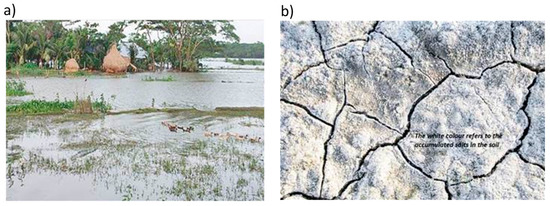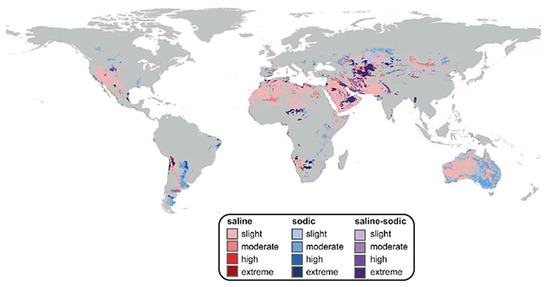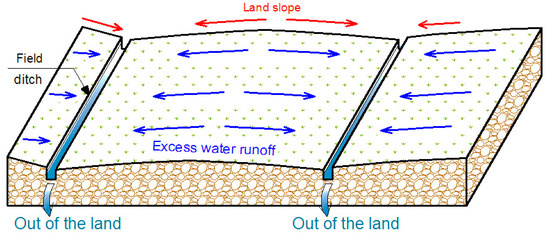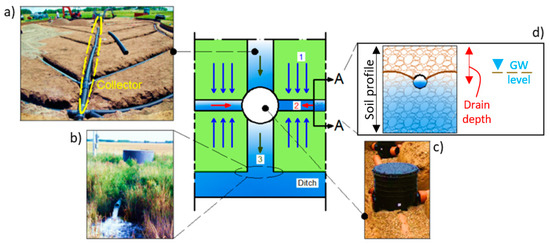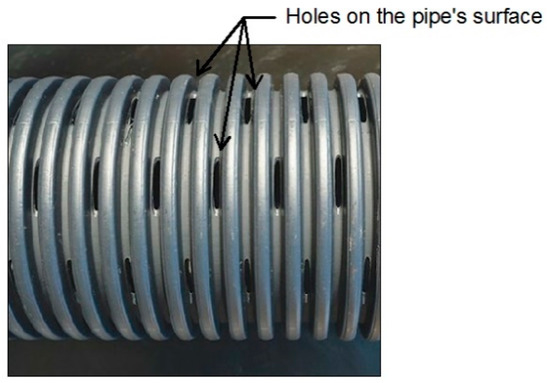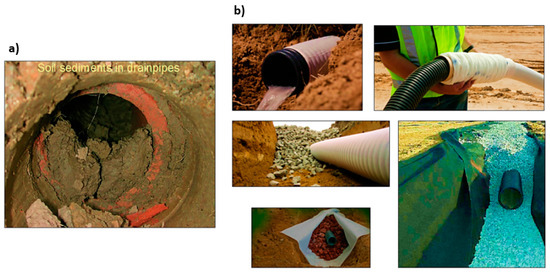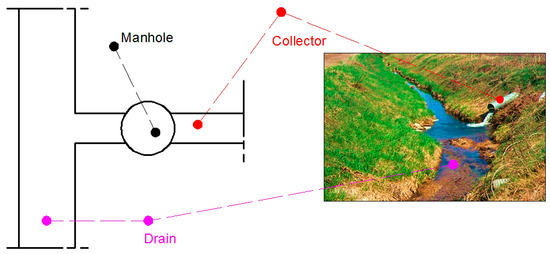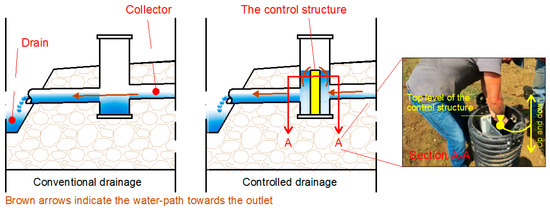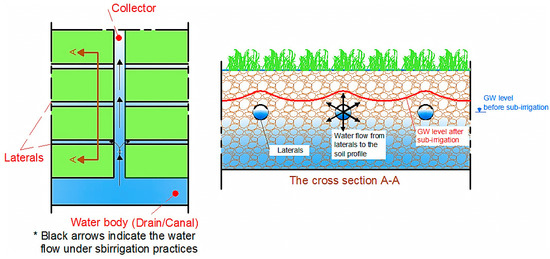Water that exists in farmlands may exceed the crop water requirements, and this may occur under the following conditions:
In general, the benefits of practicing agricultural drainage include, but are not limited to, the following:
Practicing agricultural drainage in wet and swampy areas led to a remarkable reduction in mosquito breeding sites, which causes a drop in the incidence and prevalence of important water-related and mosquito-transmitted diseases, e.g., malaria, yellow fever, and filariasis.
As agricultural drainage strategies aim to create a path for the excess water to be discharged from farmlands, this path can exist above or under the ground, and this is what distinguishes between so-called “Surface drainage practices” from “Subsurface drainage practices”.
Surface drainage practices mainly aim to collect (through runoff) the excess water that exists on the land surface in a set of ditches that convey this water and discharge it from the farmland. To have an effective surface drainage system, the farmland topography has to be modified to create slopes toward ditches to allow excess water on the land surface to run off smoothly toward these ditches (Figure 3). On the other hand, subsurface drainage practices aim to create an underground path that collects excess water that exists in the soil profile and discharges it, whether directly to a spot outside of the farmland or to a ditch that then discharges it from the farmland.
Figure 3. Surface drainage practices.
2.3. Subsurface Drainage Systems
For subsurface drainage practices, excess water is collected in underground perforated pipes that are installed at certain depths and slopes in such a way that allows this water to flow from laterals to main collectors until being discharged from the land (Figure 4). Sometimes, these underground pipes deliver excess water directly to ditches that are dug in the land, and then these ditches discharge this excess water from the land.
Figure 4. A typical layout of subsurface drainage systems showing (a) collectors, (b) outlets, (c) manholes, and (d) the cross-section A-A that shows drainpipes buried in the soil profile (at a certain drain depth) beside the GW table during the drainage process.
2.3.1. Layout and Components of Subsurface Drainage Systems
Figure 4 shows a simple layout of subsurface drainage systems. As shown in the figure, the main components of a subsurface drainage system are:
Subsurface drainage systems are practiced mainly to get rid of the excess water that exists underground, so buried drainpipes are considered the backbone of such systems, as these pipes are the receivers and conveyors of the underground excess water. In large lands, subsurface drainage systems are designed in such a way that small-diameter drainpipes (laterals) discharge excess water into larger-diameter ones (collectors). Then, the largest-diameter pipes become responsible for conveying and discharging this water into any ditch or water body adjacent to the land. However, in small lands, laterals may be designed to discharge excess water directly into ditches or water bodies.
Drainpipes’ surfaces are perforated in a way that allows underground excess water to enter these pipes (
Figure 5). However, there is a high possibility that sand and/or silt soil particles enter from these perforations and accumulate in drainpipes, resulting in clogs in these pipes and thus hindering the drainage process. Therefore, in lands that have such soil structures, drainpipes are surrounded by proper filtering materials to prevent or mitigate any clogs in these pipes. There are plenty of filtering materials, and the choice of the proper one depends on many parameters, such as the availability of these materials, soil texture, etc. (
Figure 6) [
29,
30].
Figure 5. Drainpipe perforations.
Figure 6. Sediments in drainpipes: (a) sediment accumulation in drainpipes and (b) examples of filtering materials.
Collectors are pipes with larger diameters than laterals and receive excess water from these laterals to discharge it to either larger pipes or any surrounding water body. It is preferable to have an irrigation canal at the beginning of the collector pipe (the pipe’s highest elevation) and a drain at its end (the pipe’s lowest elevation), as this helps in performing maintenance work (known as the “washing process” of the network (Figure 7)). In such a case, water is pumped with high pressure at the beginning of the collector pipe, and as a result, water will flow in the network under high pressure to remove any clogs in the collectors to ensure the best performance of the drainage process.
Figure 7. Washing process of the drainpipe network.
Manholes are structures that are located at the intersections of two or more drainpipes (laterals with collectors/collectors with collectors) to mitigate the accumulation of sediments at these intersection points (Figure 8). Manholes are also implemented at specific spacings to divide the length of long collectors into smaller ones to facilitate the maintenance of these pipes. For example, if there is a certain issue (e.g., a clog) in the collector pipe, it is easy to check the sections between each adjacent manholes, rather than checking the whole length of the pipe.
Figure 8. Manholes, showing their structure and location.
A drainage outlet represents the point after which excess water leaves the subsurface drainage system to water bodies that surround the land. Such an outlet is mostly located at the end of a collector pipe, and, in most cases, this pipe discharges the excess water into open drains (Figure 9).
Figure 9. A typical layout showing the drainage outlet (which is mostly the end of a collector pipe).
To ensure the continuity of the drainage process, the highest designed water level in the drain or the water body (where collectors discharge excess water) should not be higher than the collector’s bottom level to prevent the submergence of collectors (outlets) in these water bodies (Figure 10).
Figure 10. Design considerations to prevent the submergence of collector pipes.
2.3.2. Special Practices in Subsurface Drainage Systems
Subsurface drainage systems have mutated and developed from only a strategy for the removal of excess water to a tool that helps to better control groundwater tables and soil moisture in agricultural lands. In the following, a brief discussion is provided about so-called “Controlled drainage [
31]” and “Subirrigation [
32]” practices, which are two examples of how to employ subsurface drainage practices for better control of groundwater tables and, thus, soil moisture.
Controlled Drainage Practices
Under common drainage conditions (conventional drainage), excess water moves from laterals to collectors and then is freely discharged into water bodies that surround the farmland. Therefore, under such conditions, any excess water in the soil is drained. Sometimes, there is a need to retain some or all of the excess water in the soil profile, and this occurs in the following cases:
For example, rice and some other crops cannot grow well until the soil is sufficiently saturated. So, the soil must retain large water amounts to achieve such saturation conditions. Under conventional drainage practices, excess water is drained and lost from the land, which decreases the water availability and thus could adversely impact crop yields. Therefore, controlled drainage practices are applied under these conditions to decrease the drainage rate or stop any drainage flux to retain the desired water amount in the land and thus ensure high crop yields [
24].
Fertilizers that are applied in agricultural lands dissolve in the soil water, and then crops’ roots extract this water to meet their requirements from fertilizers and grow optimally. Under high and unmanaged drainage rates, large amounts of this water (which contains dissolved fertilizers) are lost from the soil before being extracted by crops’ roots. This deprives crops of these fertilizers and increases the nonpoint-source pollution of surrounding water bodies that receive the drainage flux due to the dissolved fertilizers that exist in this flux. Therefore, it is sometimes preferable to decrease the drainage rate or stop any drainage flux after the application of fertilizers. Consequently, this allows crops to make the best use of these fertilizers while ensuring better quality for the surrounding water bodies [
33].
Under the abovementioned cases, it is better to practice some control on the drainage flux. This can be achieved by setting a “Control structure” before the outlet. This control structure has something like a small gate that can be moved up and down to achieve the desired drainage rates (Figure 11).
Figure 11. Conventional vs. controlled drainage practices.
Under controlled drainage practices, excess water does not flow directly to outlets. Rather, it accumulates in the control structure, or in the manhole that contains that control structure, until it reaches a level higher than the top of the control structure, and then drainage starts (Figure 11).
Subirrigation Practices
Apart from what is established in minds about drainage systems, namely, that they are installed to only lower groundwater tables in the soil profile, these systems can be managed in a different way (subirrigation practices) to exert the reverse action. Under subirrigation practices, water is pumped back into collectors to reach the laterals. As a result, water flows from these laterals to the soil profile (through the openings on the surfaces of these laterals). This increases the water availability in the soil profile, especially the root zone, and causes groundwater tables to rise (Figure 12).
Figure 12. Subirrigation practices.
2.3.3. Advantages and Disadvantages of Subsurface Drainage Practices
Compared to surface drainage practices, the main advantage that characterizes subsurface drainage practices is the high control of the drainage rate, and this, in turn, results in several advantages [
14,
26]:
-
Better control of groundwater tables.
-
Mitigation of the degradation of water body quality that results from nonpoint-source pollution when fertilizers that are dissolved in drainage water discharge in these water bodies.
Most components of subsurface drainage systems exist underground, so the installation of these systems does not cause significant losses in the area of agricultural lands compared to surface drainage systems.
As previously stated, practicing subsurface drainage strategies mitigates the runoff to adjacent water bodies, which may save them from the so-called “gully erosion” and ensure better conditions for the maintenance of their cross-sections [
34].
On the other hand, the major disadvantage of subsurface drainage systems is the high cost of installation. In addition, such systems require periodic maintenance to ensure the high performance of the drainage process.
2.4. Soil Type and Climate Patterns as Significant Determinants When Deciding the Best Drainage Strategy (Surface or Subsurface) in Agricultural Lands
To decide the best drainage strategy (whether surface or subsurface) for a particular land, it is necessary to have preliminary knowledge of the excess water fate in the land. Such a fate in agricultural lands depends largely on the soil characteristics and weather patterns. In principle, the excess water that exists in farmlands has two major fates: runoff and infiltration.
-
If the soil is highly permeable, then excess water (which exists on the land surface) easily percolates into the soil profile in a relatively short time. In this case, subsurface drainage strategies are the ideal choice since most of the excess water will exist underground in the soil profile.
-
For low-permeability soils, excess water (which exists on the land surface) takes a relatively long time to percolate into the soil profile, resulting in the accumulation of this water on the land surface. If this stagnant or retained water exceeds the surface depression capacity of the land, then runoff begins. Under such conditions, most of the excess water exists on the land surface and not in the soil profile, and thus, surface drainage strategies are the ideal choice in these lands to collect the excess water through runoff.
-
Sometimes, people may have intense precipitation patterns in lands characterized by high-permeability soils. Under such conditions, the precipitation rate may exceed the percolation of excess water into the soil profile. This may result in excess water accumulation on the land surface, which makes surface drainage strategies necessary in these lands despite having relatively high-permeability soil in the land.
-
If the climate pattern varies during the year in a particular land, it may be better to use a combination of both surface and subsurface drainage strategies to collect excess water runoff (e.g., due to heavy precipitation events) and get rid of underground excess water (when existing).
In addition to the abovementioned role of soils and climate patterns in deciding the best drainage strategies in agricultural lands, soil texture plays a dominant role in deciding the best design layout of drainage systems. Therefore, it is indispensable to properly consider different soil textures and climate patterns that exist in a particular area when deciding on the best drainage strategies and practices.
